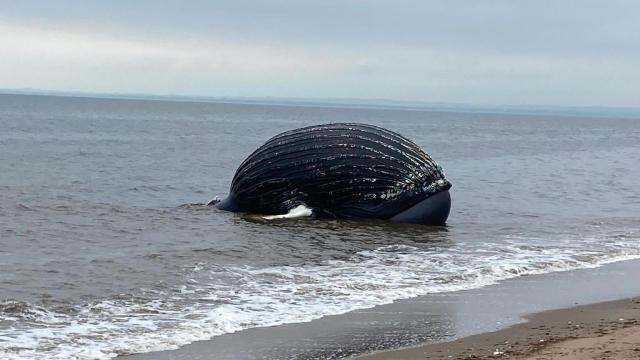The recent death of a humpback whale that ended up on the shores of Staten Island, New York this month may have involved humans. Conservation experts who examined the whale say they found evidence of at least two human-caused injuries, including metal stuck in its guts. A final determination of the cause of death has yet to be made, however.
On September 17, a 11.58 m-long male humpback whale was found dead in the shallow waters off Great Kills Park, on the south shore of the borough. After the discovery, park officials reached out to the Atlantic Marine Conservation Society (AMSEAS), which frequently helps investigate and clean up the deaths of large marine animals that wash up on land.
The group later posted an update to their Facebook page, claiming that their examination had found two injuries that were likely human-caused. The whale reportedly had healing wounds around its mouth and head indicative of having gotten caught in gear, and it had a “large piece of metal debris lodged in his intestines, causing damage to the digestive tract,” the group said. Otherwise, the whale’s body seemed to be in good condition, with lots of fish in its stomach, suggesting it had recently eaten.
AMSEAS isn’t ready to pin the blame on humans just yet, though. And it’s possible that this mystery death may never be solved.
“We are still investigating all the factors that may have contributed to the animal’s death and waiting for pathology results. Not all cases result in a definitive cause of mortality,” Joanne Biegert, office administrator at AMSEAS, told Gizmodo in an email. “It can take several weeks to months to finalise a necropsy report with pathology reports/etc. AMSEAS will post updates on social media when these results are finalised.”
It’s estimated that thousands of whales and dolphins end up stranded on land worldwide every year. Many of these strandings involve whales that have already died of natural causes and whose bodies simply reach the beach afterwards, though sometimes the whales are found alive and can be rescued. Reports of strandings date back thousands of years. But there is some worry that humans have made the problem worse, both directly through the use of sonar and indirectly through climate change making whales more vulnerable to getting lost or injured.
It’s been a busy month for AMSEAS. Less than three days after the Staten Island stranding, the group was called to yet another dead whale, a 4.57 m-long minke whale found off the coastline of Amagansett, New York, on the south shore of Long Island. This whale was also given an autopsy and was transported elsewhere to be buried. The Staten Island whale, however, was too large to be moved and was buried on site.
Biegert said there are plenty of avenues for the public to help protect marine life. “Monitoring local beaches and participating in beach cleanups are a great way to observe your surroundings while preventing harmful debris from washing into the ocean,” she said.
The organisation also hosts educational outreach programs and is currently looking for volunteers to become trained as first responders that will be deployed to the scene of a stranding. These responders are expected to keep the public and the animal safe, while documenting as much as possible, before more help arrives. A list of volunteer or educational opportunities with the group can be seen here.
